Merano Wine Festival: From Sassicaia to superb Riesling, and so much more
December 2, 2012
Things started off with glasses of Ferrari Brut Perlé 2006, from a magnum bottle. Ian d’Agata, wine critic and project manager for this Merano Wine Festival, seems to know everyone in the Italian wine world. It was the reception at the Merano Kurhaus before a large opening press dinner. And we met several well known producers, including Matteo Bruno Lunelli, president of the Ferrari wine company. The sheer elegance of the surroundings was accentuated by performance artists who danced slowly and “played” with objects – see photo at left.
Tasting Notes Links:
Double Vertical of Zind Humbrecht Rangen de Thann and Brand Riesling (6 vintages each) / Double Vertical of Taupenot Merme Charmes and Mazoyeres Chambertin (5 vintages each) / Vertical of Sassicaia / Vertical of Thanisch Berncasteler Doctor Riesling Auslese ranging from 1959 to 2011 / Vertical of St Michael-Eppan Sauvignon Blanc
Thanks to Ian, I was invited to co-host several ‘master classes’ for the festival, which is one of the world’s most exclusive wine events. Over a three day period, I was able to taste a wide variety of wines and also attend several master classes while co-hosting three. One featured six vintages each of two superb Rieslings from Domaine Zind Humbrecht, with Olivier Humbrecht (a double vertical). Another featured Virginie Taupenot-Daniel of Domaine Taupenot Merme in Morey St Denis, with five vintages each comparing two superb grands crus: Charmes Chambertin and Mazoyeres Chambertin. Finally, as fate would have it, I was asked to co-host a small vertical of the mythical super Tuscan wine Sassicaia.
Things started off with a terrific press dinner at the expansive Kurhaus, where we enjoyed a five course dinner with various wines, following the Sparkling reception. In addition to more elaborate entertainment, money was raised for the victims of an earthquake in Italy.
It was an excellent way to start things off, and I met many interesting people, including the direct descendant of the Mona Lisa. No joke. Princess Natalia Strozzi is directly related to the person with the enigmatic smile in Leonardo da Vinci’s legendary painting… And she and her family have been selling wine for many years: Tenute Guicciardini Strozzi wines, which are not very expensive in fact.
Other people I met at the dinner – as we were entertained with lively piano and singing – included Maira Gon, whose Eugenio Collavini Viticultori makes fine Friuli wine and Ursula Thurner, who organizes large tasting events throughout Italy, mainly for Tuscan wines.
I had driven about 8 hours from Strasbourg to arrive just in time for dinner. The next day, I was able to appreciate Merano. What a romantic town, just at the foot of the Dolomite Mountains, full of charm, and one can get by with German or Italian – or English.
This is the Southern Tyrol, which up until the end of World War I, was part of the Austro-Hungarian Empire (and before that, the Holy Roman Empire). As such, a Germanic speaking part of the world. But Italy won with the Allies and after the war, from 1918, it became part of modern Italy… Like Alsace, this is a ‘changed-hands’ region, where languages spoken changed according to who was ruling.
Although Alsace seems to have had a much more intense back and forth: originally part of (or associated with) the Holy Roman Empire, it was German speaking. At the end of the Thirty Years War, in 1648, it was taken by Louis XIV as part of the French kingdom, where it stayed until France lost to Bismark’s Prussian soldiers in 1871. Against Bismark’s advice, newly crowned German Emperor Wilhelm I ‘took back’ Alsace and incorporated it into the ‘Second Reich’ (a reference to the Holy Roman Empire as the ‘First Reich’). That lasted until 1918, when, after the German surrender, Alsace ‘went back’ to France. But then Hitler took it back – briefly – during World War II, after which it became part of the French Republic. Where we are today. But unlike the South Tirol, most all young people in Alsace speak only le francais… In Merano, by contrast, the Germano-Austrian heritage is wonderfully maintained, so that citizens learn both Italian and German in school. But I digress.
As you can see in the video, below, the Merano Wine Festival was packed with crowds… although an early morning arrival ensured easier tasting. For example, I was able to taste some fine wines from Ceretto in Alba. Owner Federico Ceretto was there to guide me through the wines, including some very fine Barolos.
The wines were all of fine quality, although I noticed that the alcohol levels were rather high – and could detect a warm aspect on the palate. Ceretto later said that that is the effect of climate change – that our weather has resembled “Africa” he said, at one point!
Barbera d’Alba 2011 (14.5%). Aged in stainless steel for about one year, this wine sees no oak. The attack is supple and there is good fruit, but I get a bit of heat on the finish. I was told that Barbera gets high alcohol rather quickly, like a Merlot… “Our weather has been more African in recent vintages,” he said.
Barolo Ceretto (Alba) 2008. This one clocked in at 14.5% as well. It fetches 35-40 euros per bottle.
Brunate (Single Vineyard Barolo) 2009. This is a barrel sample – it needs to age for four years. 15% alcohol, but that is not felt, exuding flavors of tobacco leaf and cherry.
Bricco Rocche Brunate 2004. This is about 14.5% and it exudes a rich strawberry aspect. Fine. But I felt like the Barolo we had for the opening dinner was more balanced….
It was great to taste a series of special Sauvignon Blanc wines from Italy in a master class: a vertical of Sauvignon Sanct Valentin from St Michael Eppan, with Hans Terzer who since 1977 has been cellar master for this fine cooperative. He is one of the foremost Italian wine experts, particular with regard to white wines.
The cooperative of St Michael Eppan counts no less than 380 hectares (270 for whites, out of which 48 are Sauvignon Blanc, and 100 for reds). The first Sauvignon Blanc vines were planted in 1985. The vines are mainly planted along the western facing slopes of the Eppan mountain at 450 to 600 meter high levels. The soils are mainly limestone and schist, as well as some clays.
The wine is fermented and aged in stainless steel tanks – no oak – and bottled after the harvest at the end of April. In this vertical, one could appreciate an increasing level of quality as the age of the vines increased… as well as perhaps increased attention to detail in the winemaking (as well as a greater choice of vines, as planting increased in the 1990s). You will notice that the second, older series of wines, pleased me less.
Wines in bold, I liked in particular. When red and bold, even more. When underlined, too, the best.
First series: 2010, 2009, 2007 and 2005
2010: Mineral nose. The evening before at dinner, we had had a South African Sauvignon Blanc that was such a superficial caricature of this grape. This wine was more serious and interesting: a rich palate, but fine acidity with some gooseberry but also red apple flavors. 3.3 pH, with about 14% alcohol – nicely integrated.
2009: Here we have a sweeter nose, with a palate that lacks verve, alas. The pH is higher and once notices a certain flabby aspect.
2007: Peach and spice on the nose, with a touch of Riesling like petrol. There is a mentholated freshness on the palate, which is pleasing, albeit with a certain botrytis aspect that some may not like (later pickings, some grapes that had a bit of botrytis). I thought it fun and spicy, although not as interesting as the 2010.
2005: Very mineral and subtle nose, with a smooth palate that exudes balance. The palate displays richness but has precision – more precise than the 2007 for example and perhaps more interesting than the 2010. Of this first series, 2005 was the best.
Second series:
2002: Pink grapefruit freshness on the aromas, delicate on the palate but linear and very pleasing, with a sneaky finish. Lower alcohol, at about 13.5. For some reason, I really loved this wine as it seemed the most subtle so far.
1999: Here we have a more evidently rich wine but there is acidity too. Still, there is something slightly less clean overall on the palate here… Not sure I really like this wine.
1994: Noticeably older in color with some hazelnut / oxidized aromatics. There is a certain pleasing marzipan aspect, that is not overbearing, but as one approaches the finish, there is a sense of slight under-ripeness. This is not bad mind you, but lacks optimal maturity.
1992: Alas, this wine is past due. The oxidized and green elements detected in the 1994 are more evident here.
Sassicaia vertical on 12 November
I was asked to co-host the tasting, although I am hardly an expert when it comes to this Super Tuscan, having enjoyed a vertical a few years back at a Decanter Fine Wine Encounter, and then again in London last year, tasted alongside Ornellaia in a double vertical where I much preferred Sassicaia. I really like Sassicaia. I have heard that they may have changed coopers and that the oak influence has become more prominent in recent vintages – at least that is what some of the (far) more experienced participants told me afterwards. In any case, we enjoyed five recent vintages of the wine, which is mainly Cabernet Sauvignon, with about 15% Cabernet Franc. As always, in bold I liked. In red and bold even more. When underlined, the most. These were all a bit too young to truly appreciate!
2009: Double decanted before the tasting. A pine freshness for the vintage, rich and velvety on the palate, a dense feel with serious tannin, as well, but ripe tannin, to be reckoned with nonetheless. Overall rather a visceral pleasure to enjoy now, but I think this wine will age quite well. This vintage obtained most votes for best to drink today among the five wines tasted.
2008: Double decanted before the tasting. While the above is more evidently ripe black currant, dark fruits, this wine exudes a more mineral, even rather iron-like, nose. We have richness as well, albeit cooler than the above, with a smooth finely grained espresso flavor coming with retro-olfaction. The palate carries serious punch, as the tannins are more foreboding, and the finish is smooth if begging for more time in bottle.
2007: This was in a sweet spot, with cedar notes, tobacco leaf, and a lovely richness on the palate, that built up to a long finish marked by freshness.
2006: Forest floor freshness on the nose, some leafiness, and perhaps not as rich as the preceding wines? One participant called it “atypical” but I enjoyed it.
2005: The nose suggests evolution but the palate is quite tannic and even somewhat tight. Most participants found this vintage to have a lot of long term potential. In the vote for most likely to last the longest, the 2005 obtained the most votes.
Tasting Notes Links:
Double Vertical of Zind Humbrecht Rangen de Thann and Brand Riesling (6 vintages each)
Double Vertical of Taupenot Merme Charmes and Mazoyeres Chambertin (5 vintages each)
Vertical of Thanisch Berncasteler Doctor Riesling Auslese ranging from 1959 to 2011
Vertical of St Michael-Eppan Sauvignon Blanc

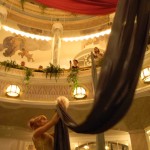
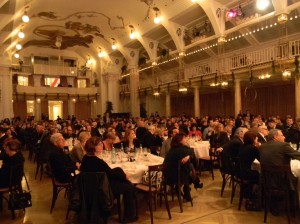
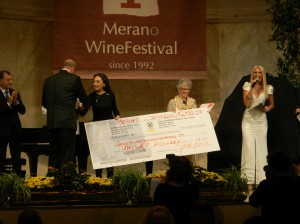


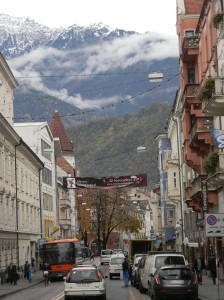
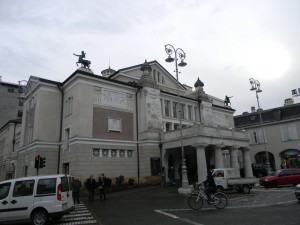
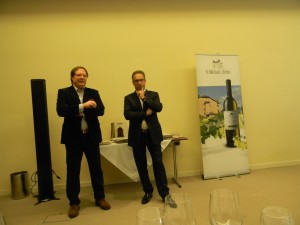
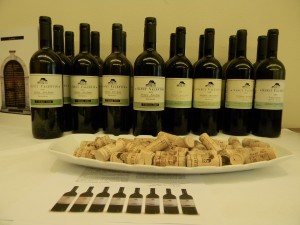
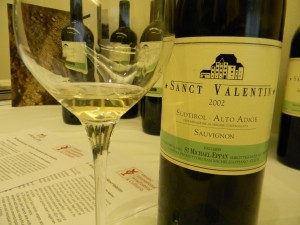
[…] the Merano Wine Festival in November 2012: Many thanks to project manager Ian […]
[…] the Merano Wine Festival in November 2012: Many thanks to project manager Ian […]